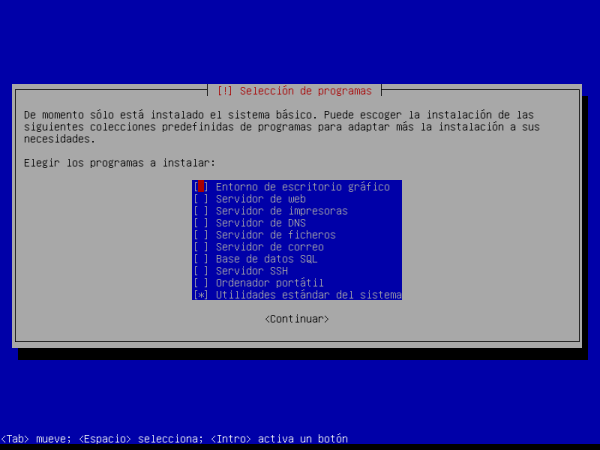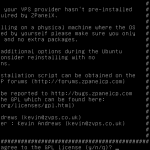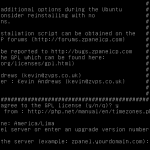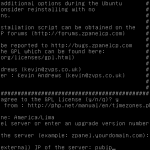Greetings to all. This time, I will teach you how to install and configure the hosting administration panel called ZPanel, which is gaining popularity thanks to its interface that initially resembled CPanel and currently has a completely understandable and easy-to-use menu.
Also, it is available for Windows if you want to try it on that platform, although I note that on that system it is literally slower than Internet Explorer 8.
While the official site indicates that there is only support for Ubuntu (both 11.10 and 12.04 LTS) and CentOS 6, I will teach you how to install the hosting control panel on Debian 7 based on the script used for Ubuntu 12.04 LTS (also known by the code name "Precise Pangolin") and thus be able to enjoy it without having major complications afterwards.
1.- System preparation
To be able to install ZPanelX en debian wheezyWe must bear in mind that we must obviously dispense with graphical interfaces in order to have a better performance of our server.
In my case, I use netinstall in order to prioritize some packages that should not be installed, since the ZPanel script is responsible for downloading, installing and / or configuring services such as Apache HTTP Server, PHP, mail service. , FTP, among other services that will be configured in an automated way.
2.- Download, installation and configuration
WARNING!: The procedures that will be done in this part, the command SU and not Sudo to be able to use the commands, in addition to not suffering errors. Any mistakes that have been made during the installation and / or configuration of ZPanel are due to human factors, so we strongly recommend that you carefully read the steps to follow in this guide.
After having taken the trouble to leave our Debian Wheezy with only the administrative tools such as aptitude, apt-get, dpkg and others, we proceed to follow the steps shown in the link in which it indicates how we should use the script to avoid service initialization problems (If you have problems with the configuration, I leave you here the post I made in this forum site to download and run the script).
Based on this, we will proceed with following the steps indicated by the ZPanel script given to us by the zVPS website, except for the step of installing the dependency "Yum install ld-linux.so.2 curl", well we will use "Apt-get install libc6 curl", since in Debian, that package includes the dependency (Many thanks to PeterCzech by the advice).
Now, we run the script and follow the steps:
- We accept the GPL license
- We define the time zone based on what it indicates the PHP website (in my case, I use America / Lima).
- We confirm if we want to continue.
- We write how we are going to access our panel with a default alias (in my case it is panel.eliotime3000.pe).
- We choose if we will access by public or internal IP (in my case, it is internal).
- We define the access key of our MySQL or MariaDB database.
- We confirm the installation and wait for our server to be automatically configured and we will automatically restart.
Note: If they cannot access through the assigned FQDN, they can write ifconfig eth0 to be able to access by the IP of the virtual machine.
That's everything for now. At least I recommend using the internal IP instead of using the public one so as not to have problems when accessing. See you and until the next tutorial.
Before I go, I leave you the following screenshots:
- Accepting the GPL license
- Setting the time zone (America / Lima)
- Choose whether to install and / or update
- Define FQDN
- Choose whether public or internal IP
- Set MySQL password
- Confirm installation








Deluxe compa, well detailed!
Regards!
You're welcome, buddy. What's more, thanks to Petercheco, who was the first to install ZPanelX on Debian Wheezy.
Considering the detail of the manual I made, I will post it on the ZPanelX forum so that you can test the panel on Debian and not just stay on Ubuntu and / or CentOS.
And how does it look after installed?
I did not have time to do the final screenshot, but I will put it anyway (I hope they will let me edit my post, because the previous times I tried, I could not).
Errata:
When installing Debian, activate the options "Web Server", "DNS Server", "File Server", "Mail Server", "SQL Database" and "Standard System Utilities" (If not If it were for the ".log", I would not have realized the tremendous gaffe I just committed).
Very well.
What would be great and I propose: an updated guide for Debian 7 to improve the look and make it similar to the distros worked as Ubuntu or Mint. That is, the correct configuration of aspects such as plymouth, font rendering (with freetype-Infinity for example), dpi for screens beyond fullHD of the retina type, the correct integration of Gtk with Qt, etc. In other words, everything that has to do with appearance, beyond icons or bars or docks…. The complicated thing of the matter. I am sure that many users would appreciate it forever.
Hello everyone, I already tried but it sends me an error related to git but when doing the base installation of the OS it is installed by default. Is there someone to whom the same thing happened to me ???
Thanks for the tutorial. I am planning to hire a DigitalOcean VPS, but I have not decided yet whether to mount the droped with debian or centos, I hope to acquire it soon to follow these steps.
Thank you.
where are the commands ???